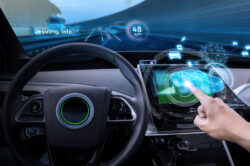As technology continues to advance, the automotive industry is no exception. The latest innovations in car electronics are transforming the way we interact with our cars and redefining what it means to be a driver. From cutting-edge infotainment systems to advanced driver assistance features, automakers have been continuously striving for more intuitive designs that improve both convenience and safety on the road.
Infotainment systems have taken center stage, integrating seamlessly with smartphones and offering a wide range of connectivity options. Voice-controlled virtual assistants are becoming commonplace, allowing drivers to easily access navigation, make phone calls, or control music playback without taking their hands off the wheel.
The rise of electric vehicles has brought about significant advancements in-car electronics. Smart charging stations, vehicle-to-grid technology, and improved battery management systems are just a few examples of how automotive electronics are shaping sustainable transportation.
In this article, we will explore these newest advancements in car electronics from infotainment systems to driver assistance technologies and discuss how they are changing the driving experience for all of us. With each breakthrough, cars are becoming more than just modes of transportation; they are evolving into intelligent, connected devices that enhance our daily lives on the road.
Exploring Infotainment Systems and Advanced Connectivity Options
The latest innovations in car electronics are making driving a more enjoyable and connected experience. From infotainment systems to advanced connectivity options, today’s vehicles provide drivers with access to a range of features that make the driving process easier and more efficient. Infotainment systems allow drivers to stay informed by providing them with news, weather updates, navigation tools, and music streaming services while they’re on the go.
With the addition of voice control support, users can quickly search for information without taking their eyes off the road. Additionally, advanced connectivity options enable cars to interact with other devices such as smartphones or smartwatches so that important notifications can be received while traveling. For those looking for additional safety precautions while out on the roads, driver assistance technologies like blind spot monitoring and lane keep assist can offer an extra layer of security when navigating busy highways or unfamiliar terrain.
These automated features are designed to help reduce accidents by providing warnings when potentially dangerous situations arise – ultimately leading to greater peace of mind behind the wheel. The combination of these advancements is allowing drivers around the world to enjoy smarter vehicles whilst feeling reassured about their safety at all times – making it clear why exploring new car electronics has become increasingly popular among modern motorists!
Understanding Driver Assistance Technology and Automotive Safety Features
Source: hasnerlaw.com
As car electronics become more advanced, the safety features available to drivers are also evolving. From driver assistance technology that helps keep a vehicle in its lane and maintains speed and distance from other vehicles on the road, to blind-spot monitoring systems that alert drivers of any potential hazards in their surroundings, automakers are equipping cars with an ever-growing suite of tools designed to maximize safety while behind the wheel.
Understanding what each feature does can help drivers make informed decisions when purchasing or renting a vehicle as well as understand how best to use them on the road. To better comprehend these technologies, consumers need to familiarize themselves with terms such as Automated Emergency Braking (AEB) and Adaptive Cruise Control (ACC). AEB uses sensors and cameras around a vehicle’s exterior to detect obstacles ahead that may result in an imminent collision; if so detected, then brakes will be applied automatically by the system without input from the driver.
ACC works similarly but instead of detecting obstacles it regulates speed according to traffic flow – slowing down or speeding up depending on surrounding conditions – allowing for a smoother driving experience over longer distances. It is also important for drivers to consider options such as automated parking assist which takes much of the stress associated with finding difficult spots out of their hands by using sensors located around your car’s body combined with camera visioning techniques that measure angles and distances between objects helping you park safely every time!
Analyzing Emerging Trends in Vehicle Electronics
Analyzing emerging trends in vehicle electronics has become increasingly important as the automotive industry continues to advance with the latest innovations. From infotainment systems that keep drivers connected and entertained while on the go, to driver assistance technologies that help make vehicles safer, car electronics are constantly evolving. While some of these developments have been around for years, others are more recent and offer new opportunities for manufacturers.
To gain insight into these advancements, it is necessary to look at both current and future trends to stay ahead of the competition. This means examining which features are popular among drivers now and what innovations may be coming down the line. For example, automakers can get an idea of how customers view autonomous driving technology by studying data from customer surveys or review online.
Additionally, they can use this information to create strategies such as offering packages with a mix of safety features tailored towards particular demographics or price points. By understanding how consumers interact with their vehicles today and researching upcoming advances in automotive technology tomorrow, manufacturers will be able to create cars that meet customer needs while staying ahead of market trends.
Source: .deloitte.com




